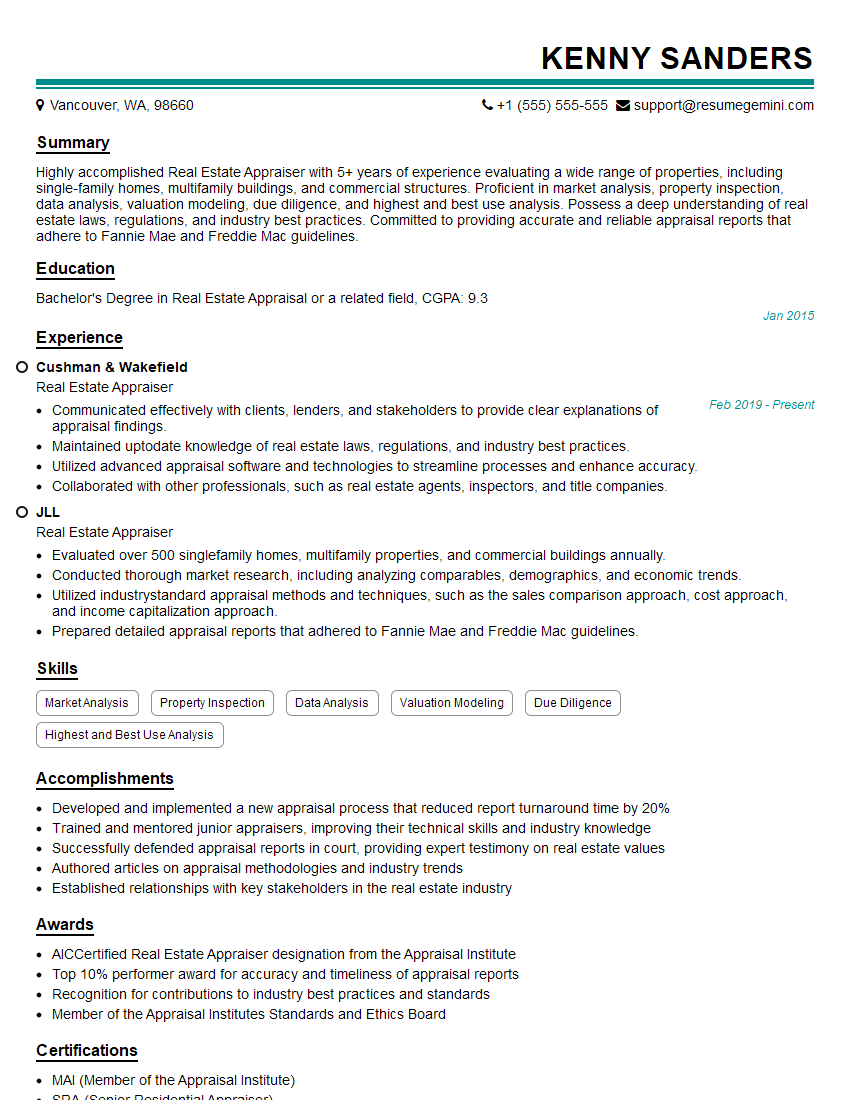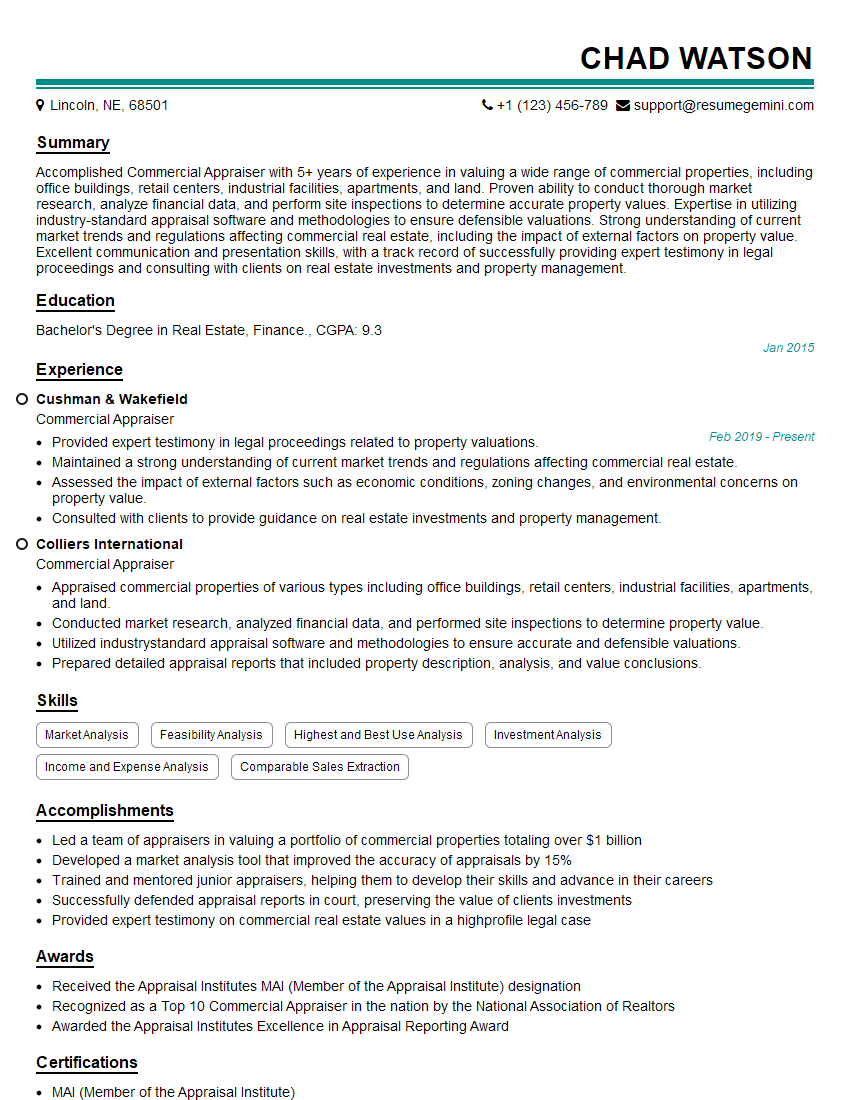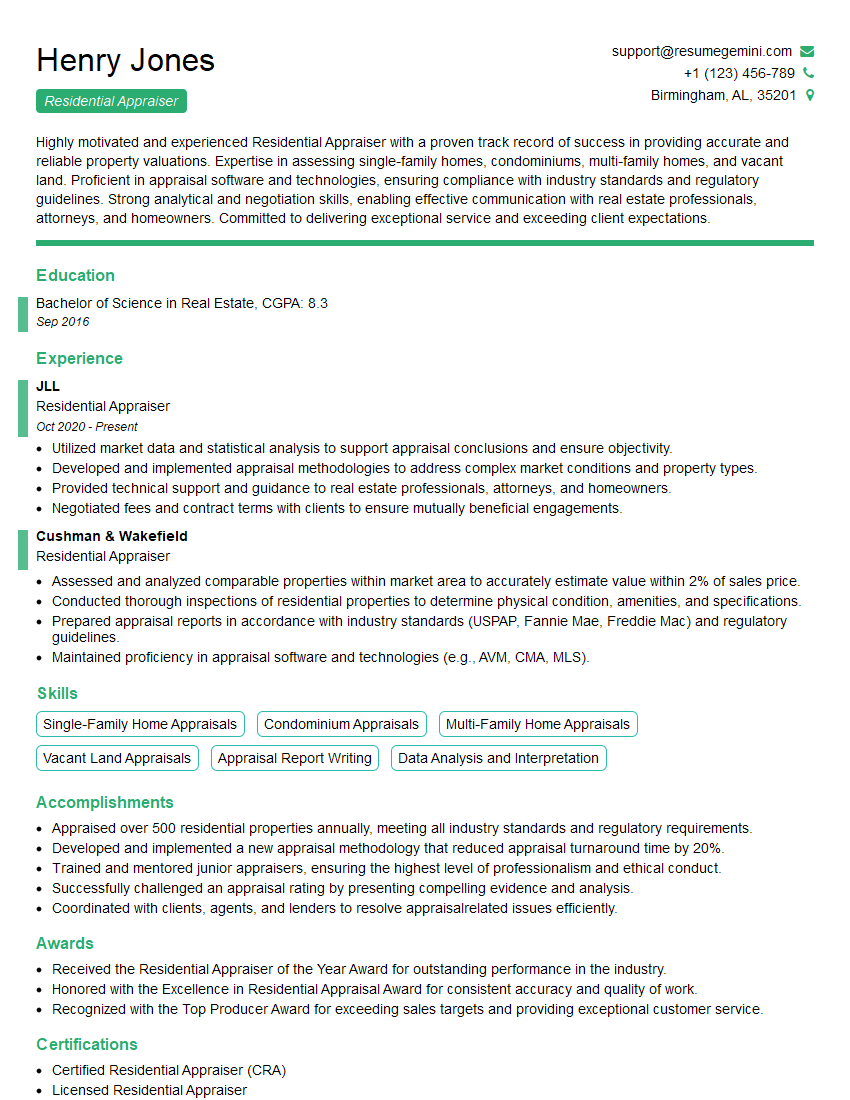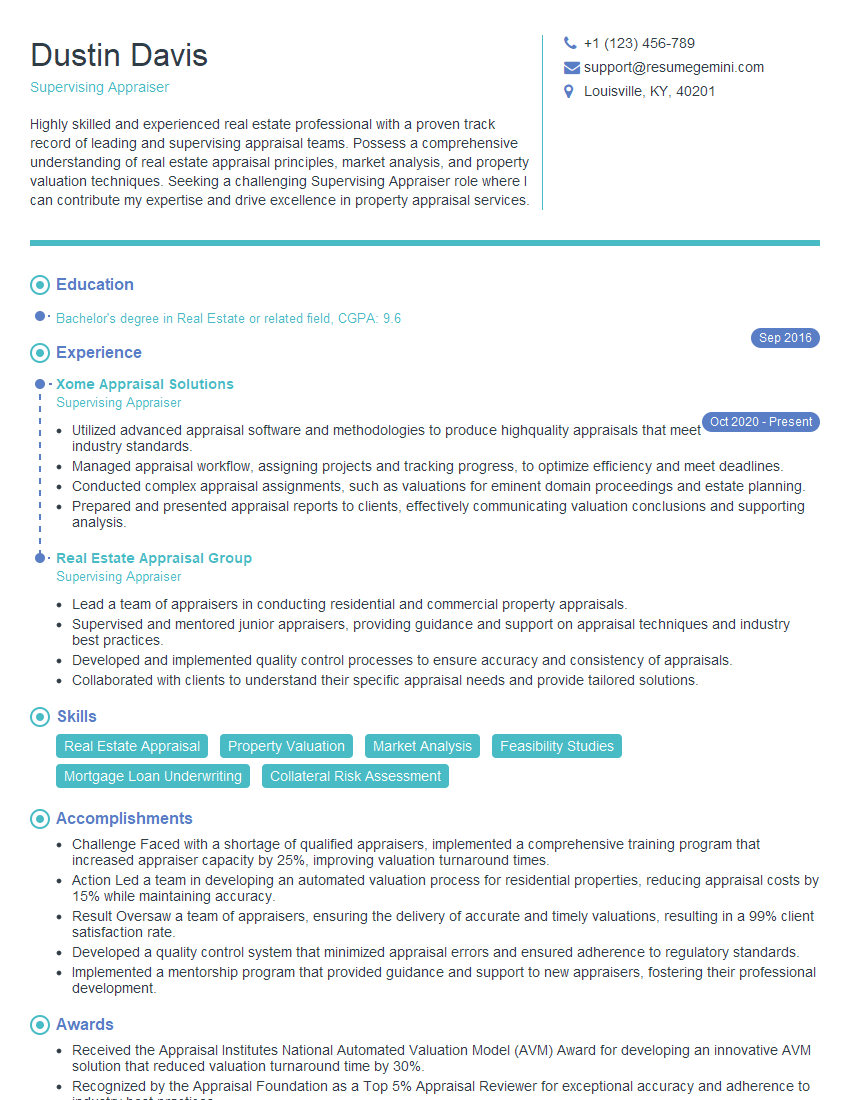Cracking a skill-specific interview, like one for Property Appraisal and Valuations, requires understanding the nuances of the role. In this blog, we present the questions you’re most likely to encounter, along with insights into how to answer them effectively. Let’s ensure you’re ready to make a strong impression.
Questions Asked in Property Appraisal and Valuations Interview
Q 1. Explain the three approaches to value in real estate appraisal.
Real estate appraisal relies on three primary approaches to value: the Sales Comparison Approach, the Income Capitalization Approach, and the Cost Approach. These approaches aren’t used in isolation; rather, they’re employed concurrently, with the appraiser weighing the results of each to arrive at a final opinion of value.
- Sales Comparison Approach: This method compares the subject property to recently sold comparable properties (comps) in the same market area. Adjustments are made to the sale prices of the comps to account for differences in features, location, and condition between the subject property and the comps. Think of it like comparing used cars – you wouldn’t expect a car with more features and lower mileage to sell for the same price as one with fewer features and higher mileage.
- Income Capitalization Approach: This approach is used for income-producing properties, such as apartment buildings or commercial properties. It estimates value based on the property’s potential to generate income. The net operating income (NOI) is calculated, and then a capitalization rate (cap rate) is applied to determine the value. The cap rate reflects the market’s required rate of return for similar investments. Imagine you’re investing in a rental property; you’d expect a higher return if the property is in a prime location and has low vacancy rates.
- Cost Approach: This method estimates value by determining the cost of replacing the improvements (building) new, less depreciation, and adding the land value. This approach is most useful for newer properties or unique properties where comparable sales are scarce. Think of it like estimating the value of a custom-built home – you’d need to calculate the cost of materials and labor to build a similar home, then deduct for depreciation.
Q 2. Describe the process of conducting a market analysis for a property appraisal.
A thorough market analysis is crucial for a reliable appraisal. It involves systematically gathering and analyzing data to understand the supply and demand dynamics of a specific real estate market. The process generally includes:
- Defining the Market Area: Identifying the geographic area that directly influences the subject property’s value. This isn’t just a street address; it considers factors like school districts, proximity to amenities, and competing properties.
- Data Collection: Gathering information on comparable sales (comps), listings, and market trends. Sources include Multiple Listing Services (MLS), public records, and local real estate professionals.
- Data Analysis: Analyzing the collected data to identify trends in prices, absorption rates (how quickly properties are selling), and market conditions. This might involve creating graphs and charts to visualize trends in property values over time. For instance, you might observe an upward trend in prices for single-family homes in a particular neighborhood.
- Market Conditions Assessment: Determining whether the market is balanced, buyer’s market, or seller’s market. This helps understand the overall pressure on property values. In a seller’s market, properties sell quickly and above asking price, while in a buyer’s market, it takes longer to sell, and prices are typically lower.
- Highest and Best Use Analysis (Preliminary): A preliminary assessment to determine if the current use of the property is the most profitable.
The market analysis informs the appraiser’s selection of comparable properties and the adjustments made to their sale prices in the Sales Comparison Approach.
Q 3. What are the key factors influencing property value?
Numerous factors influence property value. These can be broadly categorized as:
- Physical Characteristics: Size, age, condition, features (e.g., swimming pool, updated kitchen), lot size, and location within the neighborhood.
- Economic Factors: Interest rates, inflation, employment levels, and overall economic growth. Low interest rates generally stimulate the market, while high interest rates can dampen it.
- Governmental Factors: Zoning regulations, building codes, property taxes, and environmental regulations. Stricter zoning rules may limit development, potentially increasing land values.
- Social Factors: Population growth, demographic shifts, and the overall desirability of the area. A neighborhood with good schools and low crime rates tends to be more desirable.
- Environmental Factors: Views, proximity to parks or bodies of water, and the overall environmental quality of the area. A property with stunning views often commands a premium price.
The interplay of these factors creates a complex picture of value. For example, a well-maintained house in a desirable neighborhood with good schools will typically command a higher price than a comparable house in a less desirable area.
Q 4. How do you determine the highest and best use of a property?
Determining the highest and best use of a property is a critical step in the appraisal process. It’s defined as the reasonably probable and legal use of vacant land or an improved property that is physically possible, appropriately supported, financially feasible, and that results in the highest value. The process involves:
- Identifying Potential Uses: Considering all legally permissible and physically possible uses for the property, given its size, location, and zoning regulations. For example, a large piece of land might be suitable for residential development, a commercial building, or even a park.
- Analyzing the Feasibility of Each Use: Evaluating each potential use based on market demand, financial feasibility, and legal considerations. This involves analyzing potential income, construction costs, and operating expenses for each use.
- Selecting the Highest and Best Use: Choosing the use that yields the highest value after considering all factors. This doesn’t always mean the most intense use, but rather the use that produces the greatest return.
For example, a small lot in a dense urban area might have a higher value as a site for a multi-family dwelling, rather than a single-family home, despite zoning potentially allowing for the latter.
Q 5. Explain the concept of depreciation in property appraisal.
Depreciation, in the context of property appraisal, is the loss of value in a property over time. It’s a crucial element of the cost approach to value. It’s important to note that depreciation in appraisal is not necessarily the same as accounting depreciation; it focuses solely on the loss of value in real estate. It doesn’t reflect the general wear and tear that occurs with the use of an asset. Rather, it reflects the impact of physical deterioration, functional obsolescence, and external obsolescence on the property’s market value.
Depreciation is subtracted from the cost to build a new replacement structure to arrive at a final depreciated structure value.
Q 6. What are the different types of depreciation?
There are three main types of depreciation considered in property appraisal:
- Physical Deterioration: This refers to the loss of value due to wear and tear, damage, or deterioration of the physical structure. This could include things like roof leaks, cracked foundation, or outdated fixtures.
- Functional Obsolescence: This is the loss of value due to outdated features or design flaws that make the property less desirable or efficient compared to newer properties. For example, a house with a small kitchen or a poorly designed floor plan would suffer from functional obsolescence.
- External Obsolescence: This reflects the loss of value due to factors outside the property itself, such as changes in the neighborhood (increased crime rates, decline in amenities, or construction of a nearby highway).
Q 7. How do you handle adjustments in the sales comparison approach?
Adjustments in the Sales Comparison Approach are crucial for accurately comparing the subject property to comparable sales. They account for differences between the subject property and each comparable sale. The goal is to make each comparable sale as similar to the subject as possible. This is done by adding or subtracting dollar amounts from the comparable sale price.
For example, if a comparable property has a larger lot size than the subject property, a deduction would be made from its sale price. Conversely, if the comparable property has fewer bedrooms than the subject, an addition would be made to its sale price. These adjustments might be in dollar amounts or percentages.
The adjustments should be supported by market evidence and should be applied systematically and consistently to all comparable sales. Experienced appraisers will often use a grid or matrix to organize the adjustments, ensuring a transparent and understandable process.
Q 8. Describe your experience with different appraisal software and reporting systems.
Throughout my career, I’ve become proficient in several appraisal software and reporting systems. This includes widely used platforms like Appraisal Institute’s software, as well as specialized programs tailored for commercial or industrial properties. My experience spans from data entry and report generation to utilizing advanced features like automated comparable analysis and map integrations. For example, I’ve used software that helps quickly identify and analyze comparable sales within a specific radius, significantly improving efficiency. In addition to these, I’m familiar with various reporting platforms that ensure compliance with industry standards and client-specific requirements; I understand the importance of producing clean, accurate, and professional reports regardless of the software used. My experience ensures I can seamlessly adapt to different technologies and leverage their strengths to optimize my appraisal process.
Q 9. Explain the importance of using comparable properties in your analysis.
Comparable properties are the cornerstone of the sales comparison approach, one of the three main approaches to value in appraisal. Their importance lies in establishing market value by comparing the subject property to recently sold properties with similar characteristics. Think of it like comparing apples to apples – you wouldn’t compare a small, old apple to a large, juicy one and expect a fair price comparison. We look at factors such as location, size, age, condition, features, and lot size to find the most relevant comparables. After selecting comparables, adjustments are made to account for differences between the subject property and the comparables. For instance, if a comparable has a larger square footage than the subject property, a downward adjustment is made to its sale price. The process ultimately results in a range of values for the subject property, which assists in determining the most probable market value.
Q 10. How do you determine the appropriate capitalization rate for an income approach appraisal?
Determining the appropriate capitalization rate (cap rate) for an income approach appraisal is crucial because it directly impacts the property’s estimated value. The cap rate represents the rate of return an investor expects on their investment. It reflects the risk associated with the property and the market conditions. There’s no single formula; it’s a process involving several steps. First, I analyze comparable properties that have recently sold, focusing on their net operating income (NOI) and sale prices. From this data, I can calculate individual cap rates for each comparable using the formula: Cap Rate = NOI / Sale Price. Next, I’ll analyze the market for similar properties, considering factors like vacancy rates, rental growth potential, and overall market stability. These factors influence the risk profile and, therefore, the appropriate cap rate. Finally, I might also consider a band of cap rates based on the comparable analysis and overall market conditions, ultimately selecting a rate that’s consistent with market data and represents the appropriate level of risk for the subject property. This is a judgment call, requiring significant experience and market knowledge.
Q 11. How do you deal with properties with unique or unusual features?
Properties with unique or unusual features present a challenge, but also an opportunity to demonstrate expertise. My approach involves a multi-faceted strategy. Firstly, I extensively research the market to identify any comparable sales with similar, albeit not identical, features. Even a small number of comparable sales with similar features can provide valuable data. For example, if the property has a unique architectural style, I might look at comparable sales of properties with similar architectural styles, even if other features differ. Secondly, if comparable sales are lacking, I would turn to other valuation methods like the cost approach, focusing on the replacement cost of the structure, plus the value of the land. Finally, I will clearly document these unusual features in my report, explaining the methodology used to address them and how these factors might impact the valuation. Transparency and meticulous documentation are critical in such situations.
Q 12. What are the ethical considerations in property appraisal?
Ethical considerations are paramount in property appraisal. Independence and objectivity are fundamental. Appraisers must avoid any conflicts of interest, ensuring impartiality and basing their opinions solely on factual data. For example, an appraiser should not accept an assignment if they have a personal interest in the property or a pre-existing relationship with the client that could influence their judgment. Furthermore, adherence to the Uniform Standards of Professional Appraisal Practice (USPAP) is mandatory, ensuring that appraisals are performed competently and ethically. This includes maintaining confidentiality, properly disclosing any limiting conditions affecting the appraisal, and ensuring accurate and unbiased reporting. Ethical conduct maintains the integrity of the profession and ensures public trust.
Q 13. Describe your experience with various appraisal assignments (residential, commercial, industrial).
My experience encompasses a broad range of appraisal assignments, including residential, commercial, and industrial properties. In residential appraisals, I’ve valued single-family homes, townhouses, condominiums, and multi-family dwellings, utilizing various appraisal techniques based on the property type and market conditions. Commercial appraisals have included office buildings, retail spaces, and shopping centers, requiring a more in-depth analysis of income and expense streams. Industrial assignments have involved warehouses, manufacturing facilities, and industrial parks, necessitating a comprehensive understanding of the specific industry and market dynamics. This diverse experience allows me to effectively tackle diverse challenges and tailor my approach to each property type and assignment.
Q 14. How do you ensure the accuracy and reliability of your appraisal reports?
Accuracy and reliability are my top priorities. My approach is multi-pronged. Firstly, I meticulously collect and verify data from reliable sources, including public records, multiple listing services (MLS), and reputable market data providers. Secondly, I apply rigorous analytical methods, following USPAP standards and using appropriate valuation techniques. Thirdly, a thorough review process is undertaken, including a peer review where applicable, to ensure the appraisal’s consistency and accuracy. Furthermore, I always clearly document my methodology, data sources, and any assumptions or limitations in the report. This transparent approach fosters accountability and allows for a clear understanding of my valuation conclusions. My aim is to deliver an appraisal report that’s not only reliable but also easily understood by clients and other stakeholders.
Q 15. What are the common appraisal standards and guidelines you follow?
As a property appraiser, I adhere to a set of widely accepted standards and guidelines to ensure the accuracy, consistency, and reliability of my valuations. These include, but aren’t limited to, the Uniform Standards of Professional Appraisal Practice (USPAP), which I’ll discuss in more detail later. Beyond USPAP, I also follow the guidelines set forth by relevant professional organizations, such as the Appraisal Institute, and any state-specific licensing requirements. These guidelines encompass various aspects of appraisal, including the selection of appropriate appraisal methods, data collection, analysis, and reporting. For instance, when appraising a single-family residence, I would utilize comparable market analysis (CMA), considering factors like location, size, age, condition, features, and recent sales of similar properties. For commercial properties, I may use discounted cash flow (DCF) analysis in addition to other methods. My focus is always on transparency and ethical conduct, ensuring my valuations are credible and well-supported.
Career Expert Tips:
- Ace those interviews! Prepare effectively by reviewing the Top 50 Most Common Interview Questions on ResumeGemini.
- Navigate your job search with confidence! Explore a wide range of Career Tips on ResumeGemini. Learn about common challenges and recommendations to overcome them.
- Craft the perfect resume! Master the Art of Resume Writing with ResumeGemini’s guide. Showcase your unique qualifications and achievements effectively.
- Don’t miss out on holiday savings! Build your dream resume with ResumeGemini’s ATS optimized templates.
Q 16. How do you stay updated with changes in appraisal practices and regulations?
Staying current in the dynamic field of property appraisal is crucial. I achieve this through several strategies. Firstly, I’m an active member of professional appraisal organizations, attending conferences, webinars, and workshops to learn about the latest updates in appraisal practices, regulations, and technologies. These events often feature presentations by leading experts and provide invaluable networking opportunities. Secondly, I regularly subscribe to industry publications and journals, keeping abreast of new research, case studies, and legal changes impacting the profession. Finally, I utilize online resources and continuing education courses to maintain my professional certifications and licenses, ensuring I am compliant with all applicable regulations. I actively track changes in market conditions, economic trends, and legal precedents that might affect valuation techniques and methodologies.
Q 17. Explain your understanding of Uniform Standards of Professional Appraisal Practice (USPAP).
The Uniform Standards of Professional Appraisal Practice (USPAP) are the generally accepted standards for the appraisal profession in the United States. It’s essentially a comprehensive set of rules that establish ethical conduct and performance standards for appraisers. USPAP covers all aspects of the appraisal process, from the initial engagement and scope of work to the final report. It emphasizes the importance of independence, objectivity, and competence. For example, USPAP dictates the necessary steps in developing an appraisal, including identifying the problem, determining the scope of work, collecting and analyzing data, applying appropriate valuation methodologies, and presenting the findings in a clear and concise report. Non-compliance with USPAP can have severe professional consequences, including sanctions and the loss of licensing.
Understanding USPAP is paramount because it ensures that the appraisal process is credible, reliable, and protects both the client and the public interest. It provides a framework for consistent and high-quality appraisals, which are essential for informed decision-making in real estate transactions and financial reporting.
Q 18. Describe your experience with different types of property ownership.
My experience encompasses a broad range of property ownership types, including fee simple ownership (the most common type, where the owner holds complete title), leasehold estates (where the owner has the right to occupy and use the property for a specified term), condominium ownership (ownership of a unit within a larger complex), cooperative ownership (ownership of shares in a corporation that owns the property), and various forms of joint ownership (e.g., joint tenancy, tenancy in common). I’ve worked on appraisals involving residential, commercial, industrial, and agricultural properties under different ownership structures. Each ownership type presents unique considerations in the appraisal process. For instance, the appraisal of a leasehold estate would involve a detailed analysis of the lease terms, remaining lease period, and potential for renewal, as these factors significantly impact value. Similarly, the appraisal of a condominium would take into account common area expenses and the overall condition of the building.
Q 19. How do you identify and mitigate appraisal risk?
Identifying and mitigating appraisal risk is a critical part of my professional practice. Risks can arise from various sources, including inadequate data, errors in analysis, changes in market conditions, or legal challenges. To mitigate these risks, I employ several strategies. First, I conduct thorough due diligence, meticulously researching the property and the surrounding market to ensure the accuracy of my data. This involves analyzing comparable sales, reviewing property records, and conducting site inspections. Second, I utilize multiple valuation methods and apply appropriate analytical techniques to cross-check my findings and identify potential inconsistencies. Third, I clearly define the scope of work in my engagement letter, outlining the limitations of my appraisal and any assumptions made. Finally, I maintain professional liability insurance to protect myself against potential claims. Regularly reviewing and updating my knowledge base is also a key risk mitigation strategy, as this helps me to be better prepared to handle new challenges.
Q 20. How do you handle disagreements with clients regarding your appraisal?
Disagreements with clients regarding an appraisal are sometimes unavoidable. My approach is always professional and collaborative. I start by patiently listening to the client’s concerns and understanding their perspective. Then, I carefully review my appraisal report to ensure its accuracy and completeness. If the disagreement stems from a misunderstanding of the appraisal process or the report’s contents, I provide a clear and concise explanation of my methodology and findings. I also provide supporting documentation, such as comparable sales data and market analyses, to demonstrate the basis of my valuation. If the disagreement persists, I’m always willing to engage in open dialogue and consider alternative approaches to resolution. In some cases, arbitration or mediation may be necessary, but my ultimate goal is to find a mutually acceptable solution and maintain a professional relationship.
Q 21. What is your experience with reviewing and validating appraisals performed by others?
I have significant experience in reviewing and validating appraisals conducted by other appraisers. This often involves reviewing appraisals for quality control, regulatory compliance, or in cases where a second opinion is required. My review process is thorough and systematic. I meticulously examine the appraiser’s methodology, data sources, analysis, and conclusions, comparing them to accepted appraisal practices and USPAP standards. I pay particular attention to the selection of comparable properties, the adjustments made to those comparables, the overall valuation approach used, and the reasonableness of the final estimate of value. If any discrepancies or inconsistencies are identified, I clearly document my findings and communicate them to the appropriate parties. Providing objective and well-supported reviews ensures the integrity and reliability of appraisals, crucial in supporting sound real estate decisions.
Q 22. How do you handle appraisals in a rapidly changing market?
Appraising property in a volatile market requires a nuanced approach. My strategy focuses on adapting my valuation methods to account for the rapid changes. This means placing greater emphasis on recent comparable sales data, closely monitoring market trends through various indices and local market reports, and employing advanced statistical techniques to account for market volatility. Instead of relying solely on historical data, I prioritize recent transactions – even if the sample size is smaller – to reflect the current reality. For example, if interest rates have sharply increased, I’ll incorporate this into the analysis by adjusting the capitalization rate used in income approaches or acknowledging the impact on buyer behavior in the sales comparison approach. Furthermore, I’ll carefully document the market conditions and any assumptions made, ensuring complete transparency in my report.
I also utilize advanced analytical tools and software that account for market fluctuations to generate more accurate valuations. This might involve incorporating seasonal adjustments or using regression models to predict future trends based on current data.
Q 23. Describe your process for preparing and delivering a final appraisal report.
My process for preparing and delivering a final appraisal report is rigorous and adheres to the Uniform Standards of Professional Appraisal Practice (USPAP). It involves several key stages:
- Data Collection and Analysis: This includes gathering data on the subject property, comparable properties, market conditions, and economic data. I utilize various tools including GIS mapping and online databases to ensure comprehensive data collection.
- Valuation Approach Selection: I select the most appropriate valuation approaches (sales comparison, income capitalization, cost approach) based on the property type and market conditions. For example, a high-rise office building would be more suited to the income approach, while a single-family home would lend itself more to the sales comparison approach.
- Valuation Calculations and Reconciliation: This involves performing the appropriate calculations for each approach and then reconciling the results to arrive at a final value. This reconciliation step is crucial, often involving a weighted average to reflect the strengths and weaknesses of each approach given the market context.
- Report Writing and Review: I prepare a comprehensive report that clearly outlines my methodology, data sources, assumptions, and final value conclusion. It also includes any limitations of the data or methodology employed. A thorough internal review is done before the report is released.
- Delivery and Communication: Finally, the report is delivered to the client, and I’m available to answer any questions or clarifications they may have about the process or findings.
Q 24. What are your strengths and weaknesses as a property appraiser?
My strengths lie in my analytical abilities, attention to detail, and my ability to adapt to diverse market conditions. I’m proficient in multiple valuation approaches and skilled in utilizing various software and databases. I also excel at communication, effectively conveying complex information in a clear and understandable manner to both technical and non-technical audiences. For example, I recently successfully navigated a complex appraisal involving a mixed-use property, requiring a thorough understanding of both residential and commercial valuation techniques.
One area where I aim for continuous improvement is expanding my knowledge in specialized property types, such as large-scale industrial complexes. While I am familiar with the principles, gaining hands-on experience in this area would enhance my expertise significantly. I actively seek opportunities to learn and grow professionally.
Q 25. What are your salary expectations?
My salary expectations are commensurate with my experience, skills, and the responsibilities of this position. I’m open to discussing a competitive compensation package that reflects the market rate for a qualified appraiser with my expertise.
Q 26. Why are you interested in this position?
I’m very interested in this position because of [Company Name]’s reputation for excellence and commitment to professional development. The opportunity to work on a diverse range of projects within a collaborative and supportive environment is incredibly appealing. I’ve been particularly impressed by [mention a specific project or initiative of the company], and I believe my skills and experience align perfectly with your team’s needs. I’m confident that I can make a significant contribution to your organization.
Q 27. What are your long-term career goals in property appraisal?
My long-term career goals involve becoming a highly respected and sought-after expert in property appraisal. I aspire to achieve MAI designation (Member of the Appraisal Institute) and potentially specialize in a niche area, such as high-value residential or commercial properties. I am also interested in exploring opportunities to mentor junior appraisers and contribute to the ongoing professional development within the appraisal field. Ultimately, I aim to utilize my expertise to contribute meaningfully to the accuracy and integrity of property valuations within the industry.
Q 28. How do you handle pressure and tight deadlines?
I thrive under pressure and consistently deliver high-quality work even with tight deadlines. I’m a highly organized individual, utilizing project management tools and time-management techniques to prioritize tasks and allocate resources efficiently. For instance, when facing a particularly demanding deadline, I break down the appraisal process into manageable steps and create a detailed timeline to ensure all components are completed on time. I also proactively communicate with clients and stakeholders to manage expectations and prevent potential delays.
Key Topics to Learn for Property Appraisal and Valuations Interview
- Fundamentals of Valuation: Understanding the three approaches to value (income, sales comparison, and cost) and their applications in different property types.
- Market Analysis: Conducting thorough market research, identifying comparable properties, and analyzing market trends to determine accurate values.
- Data Collection and Analysis: Mastering data sources (public records, MLS, etc.), interpreting data, and using statistical methods for property value estimation.
- Income Capitalization: Calculating net operating income (NOI), applying capitalization rates, and understanding the various methods for income capitalization.
- Cost Approach: Estimating land value, calculating reproduction/replacement costs, and accounting for depreciation.
- Sales Comparison Approach: Identifying and analyzing comparable sales, making adjustments for differences between properties, and applying statistical analysis.
- Highest and Best Use Analysis: Determining the most profitable and legally permissible use of a property.
- Appraisal Reporting: Understanding the Uniform Standards of Professional Appraisal Practice (USPAP) and preparing clear, concise, and comprehensive appraisal reports.
- Legal and Ethical Considerations: Navigating relevant regulations, maintaining ethical standards, and understanding professional responsibilities.
- Software and Technology: Familiarity with appraisal software and other relevant technologies used in the industry.
Next Steps
Mastering Property Appraisal and Valuations opens doors to a rewarding career with excellent growth potential. This field demands strong analytical skills, detailed knowledge of real estate markets, and the ability to communicate complex information clearly. To significantly increase your chances of landing your dream role, it’s crucial to present your qualifications effectively. Creating an ATS-friendly resume is essential in today’s job market. ResumeGemini is a trusted resource that can help you build a compelling resume that highlights your skills and experience in the best possible light. Examples of resumes tailored to Property Appraisal and Valuations are available through ResumeGemini, helping you showcase your expertise to potential employers.
Explore more articles
Users Rating of Our Blogs
Share Your Experience
We value your feedback! Please rate our content and share your thoughts (optional).
What Readers Say About Our Blog
Hi, I’m Jay, we have a few potential clients that are interested in your services, thought you might be a good fit. I’d love to talk about the details, when do you have time to talk?
Best,
Jay
Founder | CEO





